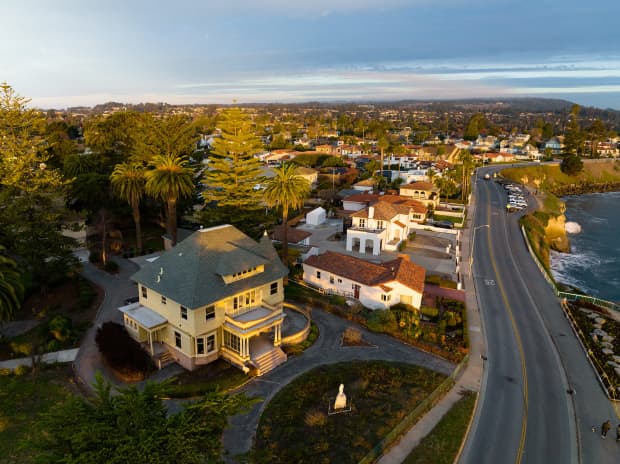When Winter Park fires up its ski lifts for the coming season, there just might be enough employees to load butts into them, maintain the hits at Lower Rail Yard, bus tables at Doc’s Road House and crank out tune-ups at Divide Board Shop. The resort just invested in a housing project to provide a roof over the heads of some 330 employees. Not only does the mix of studio and single-bedroom units ensure that there’s someone to deliver pizzas this winter, but it’s an opportunity for a young skier or snowboarder to live near the hill. Likewise, Vail Resorts has some 2,000 beds in Summit County and another 1,200 in Eagle County for employees. This is happening in ski towns across the country as the price of real estate has literally doubled since 2019 and the days of five shred kids finding an affordable three-bedroom duplex that smells like wet boots and cheap weed are long gone.
It’s an opportunity that surfers don’t very often have.
This year the average single-family home price in California is $730,000. That’s a stretch for anyone, much less a person who values the kind of free time it takes to have any kind of surf life. It also doesn’t guarantee that you’re anywhere near a wave (unless it’s the Surf Ranch. And you can’t afford to do that either.)
There’s no such thing as workforce housing if you want to ride your bike to T-Street. And it would seem that pretty soon, Gen Z’ers on 5’4” twinnies and millennial couples may not be able to live within any kind of close approximation to the zone that inspires our very beings.

Ryan “Chachi” Craig
Much like the old mountain pads once rented by noodle-eating snow shredders, generations of young surfers once packed into apartments, converted garages, bungalows and casitas. If we wanted to live near the beach, we’d work and pay reasonable rent and still have money to hit Mainland Mex. As we matured or mated, we rented nicer studios, condos or cottages. The goal was to eventually buy a home where you could still run down to the beach if the wind died down.
And that worked out well for coastal towns, which were heavily tourism-based and needed an army of young (semi-reliable) folks to cut bait, lifeguard, give surf lessons, make sandwiches, and clean pools. As they got older, they became the managers, charter captains, massage therapists, electricians, realtors and contractors.
During the real estate spike of the mid-2000s, the median US home sale price went from $200,000 to $300,000. That takes into account homes in landlocked states. The number of folks drawn to the coast and real estate near the ocean (and specifically any breaking wave) rose dramatically even before the pandemic. Fifteen percent more people live near the coast than in 2000. Homes are larger because builders make more profit at more per square foot. All of this is pricing out the first-time buyers or modest rentals.
And since 2020, wealthy people who had never lived in a beach shack with a leaky toilet and broken surfboards under the deck suddenly had a to have their own piece of the coastal experience. Then throw in a national housing crisis.
While new “investors” use beach properties as short-term vacation rentals to generate quick income, many are not invested in the actual coastal community and they’ve taken the places that surfers used to live in off the market. From Ogunquit, Maine to Solana Beach, Indialantic and Makaha, it’s a major struggle for younger surfers to own places of their own. Gentrification is as talked about in Santa Cruz as in Brooklyn.
St. Augustine, Florida’s Gabe Kling has a unique perspective on coastal real estate. He grew up in this charming barrier island town just south of Jacksonville and had a fifteen-year-long pro career, taking some 6-star events and doing several years on the ‘CT.

“I don’t think I ever paid more than $500 rent back then,” he laughs. Still carving those sweeping backside hacks while he, his wife and three kids are hyper-involved in the local beach community, he’s an agent for Endless Summer Real Estate, helping some folks find their dream vacation spot while also guiding surfers just trying to stay in their own coastal towns.
“Surfing and the coast in general have become so much more popular in the last 20 years. Everyone wants to have a house at the beach and we’re seeing the effects of it first-hand. Affordability is a genuine issue.”
Kling is thankful to be established and own, but he feels for the younger surfers trying to find a place to buy.
“You have a young couple or family that has a good job, works hard and wants to have a life by the beach, but there’s very limited options. Interest rates are not making it easier. We’re struggling to find them that spot near the ocean.”
He adds that they’re competing against older people who can afford to put down a big chunk and tries to help out younger locals by finding rentals where he can.
But Kling points to some regulations for protecting local housing. The municipality allows builders more density on a property, an incentive for affordable housing. St. Augustine Beach only awards 100 transient rental (Airbnb/VRBO) permits in its medium-density residential areas and the rental owner must be licensed. But it only works when enforced and enforcement is inconsistent around the state of Florida.
Malibu’s properties are more famous than First Point. Geographically, you can’t claim local status without $4.2 mil for a spot – the current median sale price. But even beyond Malibu, any place to sleep, eat your granola, grow your succulents, and keep your quiver west of the I-5 is a small miracle if you aren’t a heart surgeon or senior software engineer for Apple. The average home sale price in surf-adjacent Orange or San Diego Counties is over $1 million.
“We call it the missing middle in Santa Barbara,” says Greg Minus, president of the South Coast’s Coastal Housing Coalition Board of Directors, a group working to keep a diverse and sustainable community near the coast of Santa Barbara County, where people can live in the same city where they work. They want to ensure that the children that grow up near that coast don’t have to move away when they leave Mom and Dad’s.
The middle class has been squeezed out in the past 20 years – making too much to qualify for public affordable housing, but not enough to keep up with property value that’s stacking up like unexpected canyon sets.
Minus grew up as a surfer in San Diego and moved to the South Bay for college, where he stayed. In his 20s, renting a spot with his homeboys not far from the beach wasn’t a huge challenge.
But that was a different time. He explains that houses in little surf towns that are the fabric of the California coast were bought in the 60s and 70s by people of modest means. That generation had a huge influence on surf and beach culture. Small-town vibes and more space were part of an esthetic. Most of us still value that … in theory. But it hasn’t allowed for the towns to grow, making their properties crazy expensive to the following generations. Businesses have trouble finding the kind of local employees who would roll into work after the morning glass.
“The people being priced out now are the backbone of the economy – the teachers, the firefighters, young architects, maybe some people who work at city hall,” says Minus. “So then when neighboring towns get expensive, those people wind up buying a home that’s an hour away. Add up all those people who have to commute and we have bumper-to-bumper traffic. We have more pollution. And now those people are sitting in their cars instead of participating in their local community – whether they are by the coast or 40 miles away.”
He also has a company called Cam Land and Development Inc., which helps builders navigate the process of permits and land use to build homes for working folk.
“It’s become a matter of generational wealth,” explains Minus. “The kinds of people who own those properties can maybe pay $1.5 million for a three-bedroom, but until we have state-mandated housing policies, until we get supply to meet the demand, I don’t see how it will be affordable.”
Krystal Aguire is a 29-year-old stylish longboarder and swim instructor from Long Beach Island, New Jersey. Her town booms in the summer but only about 25 percent of the homes are year-round residents. Most friends her age still live with their parents but Aguire’s family no longer resides in the area. Though rent is high on the island, she feels lucky that she had a friend with an available apartment.
“The wealth disparity is taking the ability of any normal working-class person or family to live near the beach, slopes, or really anywhere desirable,” she explained.
For three years, she had lived in a reasonable apartment where she could walk to surf. Her neighbor was a salty fisherman who had resided downstairs for 18 years. Traditionally, they were the kind of year-round lifeblood of any surf town. Many of the homes have been bought by out-of-towners, then bulldozed to make room for massive houses that fetch big money from vacationers during the ten weeks of summer. Now the average home even across the 3-mile-wide Barnegat Bay costs $513,000-plus. Those homes are growing scarce and event rentals are becoming a needle in a haystack of second-home investments.

Anna-Marie Janssen/@annamariejanssen.com
“I was forced to move out of the last spot because my landlord was cashing in on his investment property,” she explained.
There are no regulations safeguarding locals or the workforce here. Where the 1960s-era duplex once was, sits a new 6,000-square-foot single-family home that’s on the market for $2.1 million. A lot of small businesses are closed more weekdays because there’s nowhere for employees to live.
Minus adds that in California’s idyllic coastal hamlets, policymakers must decide how much they are willing to change their zoning rules.
“We have to ask hard questions. If building codes allow for maximum heights of 40 feet, are we okay with 50-foot buildings to retain the community,” he offers.
Investors have no responsibility to maintain the charm of coastal areas anywhere in the country. Profits tend to win out over culture. How many generations before you have to be a millionaire to be a local surfer?
“As the daughter of immigrant parents, there’s no generational wealth coming my way,” adds Aguire, “Once I can’t find an affordable year-round rental in my beach town, I’m going to be forced to pack my things and move away from the place I’ve called home for my whole life.”

